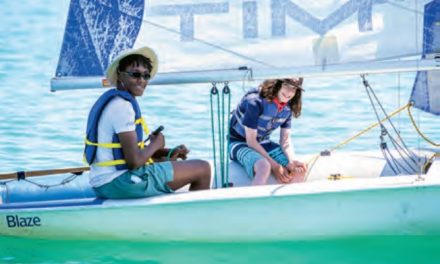Georgia’s Cumberland Island is a land of strange beauty and rich history.
Issue 134: Sept/Oct 2020
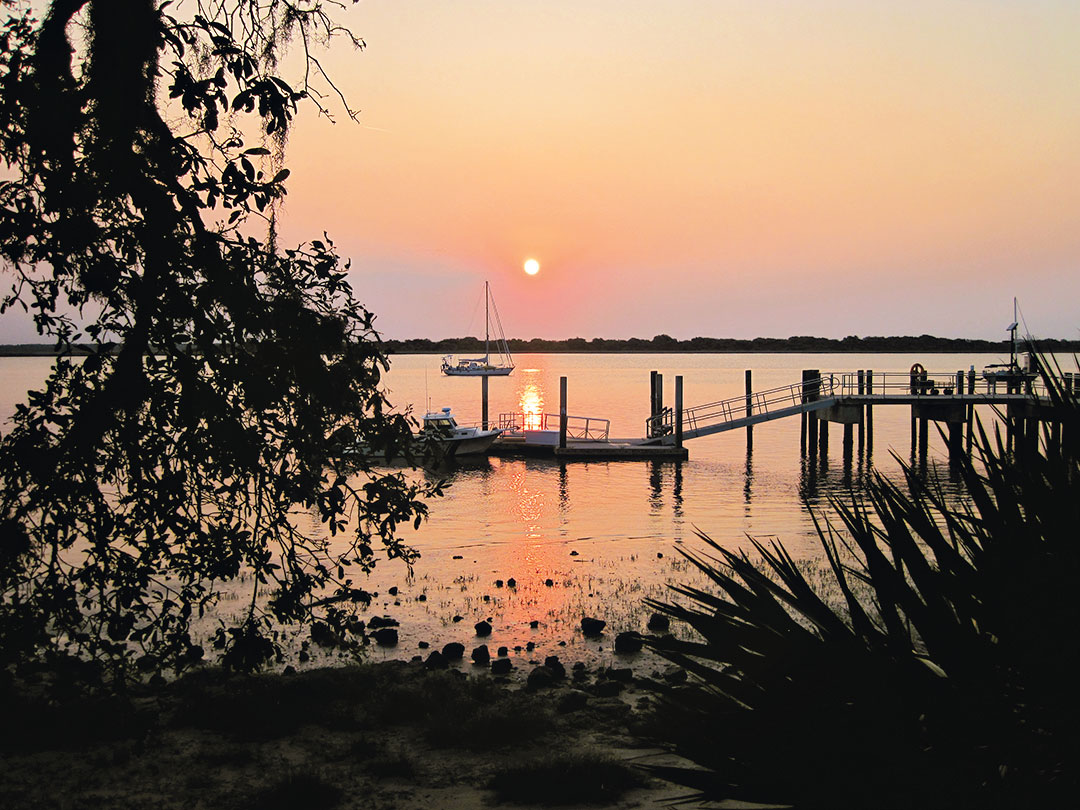
The Clarkes’ Adams 45, Osprey, rests in the anchorage at Cumberland Island while the sun sets over the saltmarshes beyond. The Sea Camp dock is in the foreground.
It may be the world’s largest Thanksgiving potluck. Six miles up St. Marys River, the dividing line between Georgia and Florida, something like 170 boats were moored, anchored, and rafted off the little town of St. Marys, famous for hosting this annual rite of southbound snowbirds on boats. But this was my first Thanksgiving without my mom, and when more than 300 sailors gathered ashore for the feast, it was all a bit much. We’d just sailed 24 hours from Charleston, South Carolina, and I felt overwhelmingly lonely in the crowd of jovial strangers who all seemed to know one another.
“Can we just go to the island?” I said to my husband, Johnny. And so our crew, which also included our two kids, retraced our tracks downriver and anchored in a sliver of cove alongside Cumberland Island’s southwestern flank, just off a floating dock where a ranger station overlooked the water. From there, a short dinghy ride led us to a land of history and natural beauty, silence and ghosts.
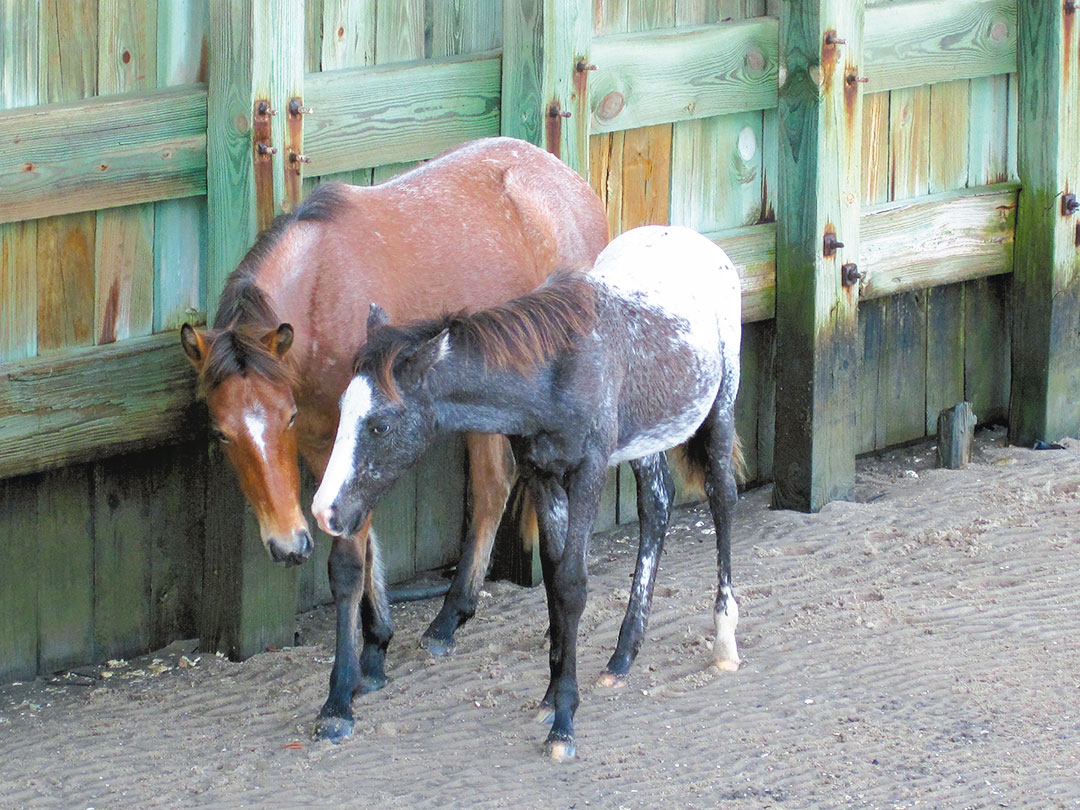
A mare and foal walk along the bulkhead at low tide near the island ranger station. The feral horses on Cumberland Island are descendants of the horses used for farming and transportation in the 1700s, 1800s, and early 1900s.
Awed and beguiled, we spent days here on that first visit, hunting for fossilized shark’s teeth, walking the miles-long pure white beach along the Atlantic, meandering through the twisted, salt-pruned live oaks of the maritime forest, and visiting the National Historic District of Dungeness and the ruins of Thomas M. Carnegie’s 1880s-era estate. Wild ponies strolled the dunes and armadillos skittered under the sawtooth palmettos. It was like nowhere we had been, exotic and mysterious, a fantastic blend of human history and natural beauty, imbued with a kind of stillness that seemed to whisper its stories.
“There is something in the trees and the palmettos and the Spanish moss, or maybe just the spirit of the place, that quiets everything down,” I wrote in my journal. “When you walk on the trails, sound is muted, absorbed. Even the distant sound of the surf hitting the beach on the east side is strangely quiet. Amid these huge old gnarled oaks—Gandalf trees, the kids call them—I feel the weight of time and evolution. Not weight as in a burden, but as in the wisdom of time, the ancient-ness of things.”
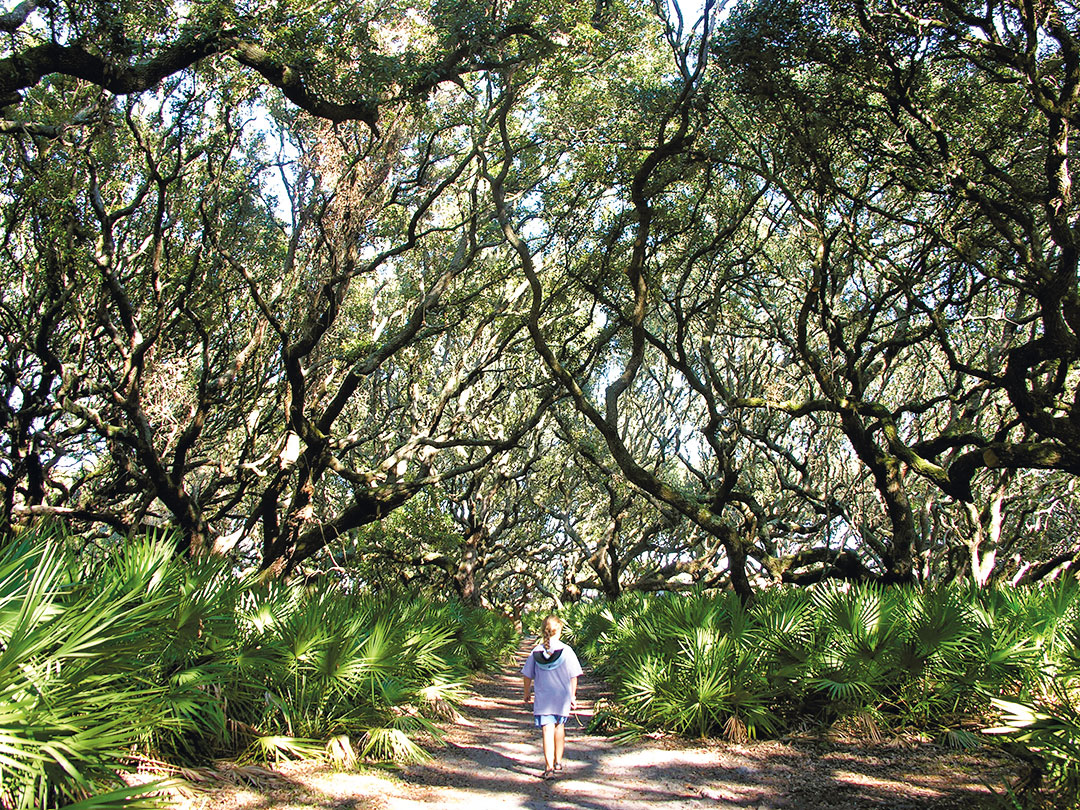
A young Kailani Clarke walks among the live oaks of the maritime forest at Cumberland Island National Seashore.
It felt like a place that hadn’t let go of its history, where the past was still somehow very present. And we found, over nearly five years and 25,000 miles of sailing that followed, that we could never quite let go of it. We would return to Cumberland Island several times, on each visit finding something new and unforgettable.
The proper name for the place is Cumberland Island National Seashore, an 18-mile-long island of over 9,000 acres comprising diverse ecosystems of dunes, saltmarsh, beach, and maritime forest. It’s the southernmost of Georgia’s barrier islands, with the St. Marys River inlet carving its southern tip.
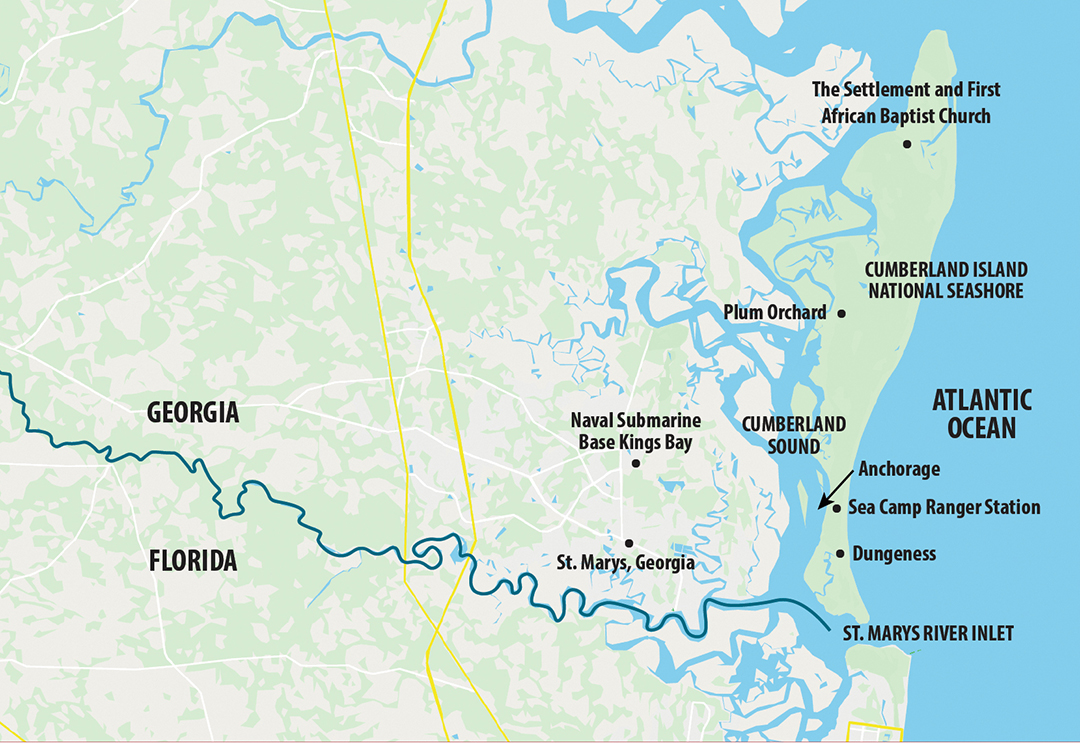
To the east is the Atlantic, to the west Cumberland Sound, part of the Intracoastal Waterway. Across the sound to the west is also Naval Submarine Base Kings Bay, whose orange-yellow loom we saw well offshore as we approached our destination that first trip. On a later visit, we would scoot through the inlet just ahead of one of the massive Ohio-class ballistic missile subs that call this base home.
On our first visit, one of the rangers told us to walk down past Raccoon Flats, where we would find mountains of spoil put here when the channel was dredged, years ago, to accommodate these subs.
“It’s the best place on the island to find fossil shark teeth,” she told us, and although it’s possible to walk the sandy paths of Cumberland and find sharks teeth everywhere, we spent many hours patiently excavating those piles of dirt, coming home with treasures of ancient teeth of jet black and gray, still sharp enough to cut.
The only way to the island is by private boat, on the private ferry run by the Greyfield Inn (see Resources sidebar), or aboard the small ferry from St. Marys. The latter brings campers who pitch their tents in a variety of campgrounds on the island, and day visitors who want to see the ruins at Dungeness or tour Plum Orchard, a fully restored Georgian Revival mansion built in 1898. We shared the anchorage with a handful of other boats, and each night, when the day visitors boarded the last ferry back to St. Marys, I always pinched myself because I was lucky enough to stay and watch twilight settle over the island.
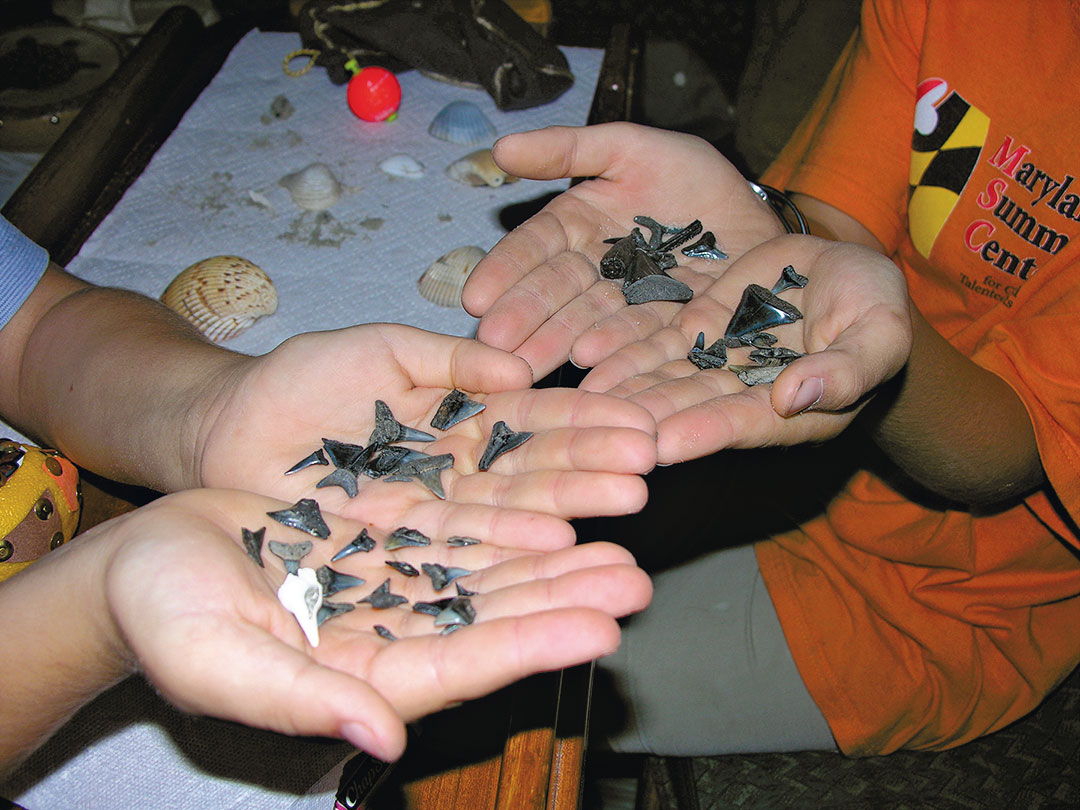
Part of a day’s haul of hunting for shark teeth on Cumberland Island.
The island’s history is a microcosm of the American experience from pre-contact through the Industrial Revolution and the early 20th century. There are few visible traces left of its first inhabitants, the Tacatacuru of the Timucua people who lived in what is now northern Florida and southern Georgia. In the late 1500s, the Spanish settled Georgia’s Sea Islands and in 1569 built a large fort on Cumberland. They followed it in 1587 with the San Pedro de Tacatacuru mission, purposed to convert the Tacatacuru to Catholicism. Like so many native peoples, the Timucua had no immunity to European diseases, and by 1595, their population in the region, estimated at one time at 200,000, had been wasted to 50,000. By the turn of the 18th century, the tribe was extinct.
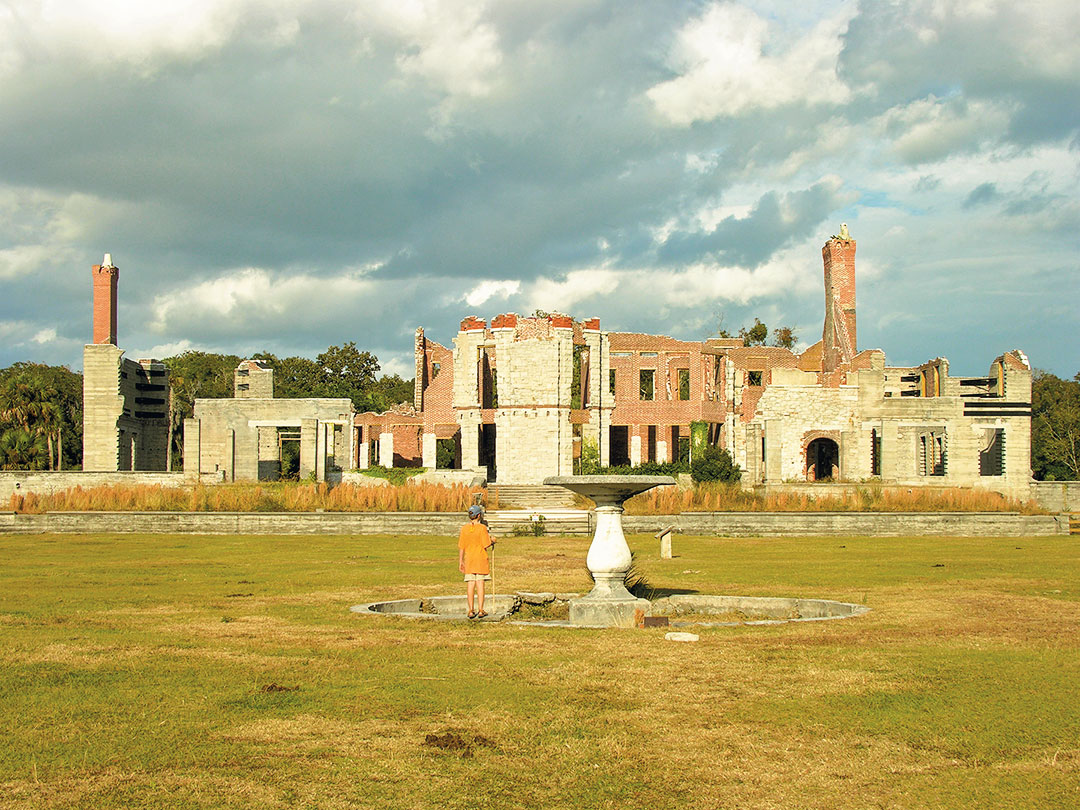
The ruins of Dungeness, the estate of Thomas M. Carnegie, dominate the island’s southern end.
Spanish occupation gave way to English aspiration when James Edward Oglethorpe, founder of the colony of Georgia, took possession of the island, named it Cumberland, and built a hunting lodge he called Dungeness near its southern end. In 1803, Catherine Littlefield Greene, widow of Revolutionary War Continental Army Gen. Nathanael Green, built a home here; the British occupied it during the War of 1812, and the house burned in 1866, although a dwelling called the Tabby House or Nathanael Greene Cottage remains. (On one of our walks we wandered past an old cemetery and found the headstone of Gen. Henry “Light-Horse Harry” Lee, father of Robert E. Lee, who died at Greene’s home and was buried here.)
According to the National Park Service (NPS), about 10 plantations occupied the land by the Civil War, all of them producing cotton by the labor of some 455 slaves. When the plantation system collapsed after the Civil War, the Carnegie family’s influence began with Thomas M. Carnegie, brother of American industrialist Andrew Carnegie, who bought a 1,891-acre estate and built a 59-room Queen Anne-style mansion, calling it Dungeness. It burned in 1959 and now stands as a marvelous wreck, where wild ponies wander about the once-pristine grounds and its enormous, elaborate fountains.

Lucy Carnegie commissioned construction of Plum Orchard in 1898 for her son, George, and his new wife, Margaret Thaw. Thaw added two large wings to bring its total size to 22,000 square feet.
In 1898, Lucy Carnegie built Plum Orchard for her son and his new wife. In 1972, the NPS acquired the island, much of it—including Plum Orchard—donated by descendants of those early elite families. On one of our visits, we rented bikes (available through the ferry boat operator) and rode the 7 miles from the ranger station north to Plum Orchard to tour this example of the opulent lifestyle of that era’s rich and famous.
The free guided tour took us through the main foyer and dining room, upstairs through some of the bedrooms and downstairs through the kitchen, even to the basement to see the original coal-fired furnace. Among the remarkable pieces on display were two tortoise-pattern Tiffany lamps in the library; a story in Ameliaislandliving.com says the NPS has estimated the lamps are worth $5 million each.
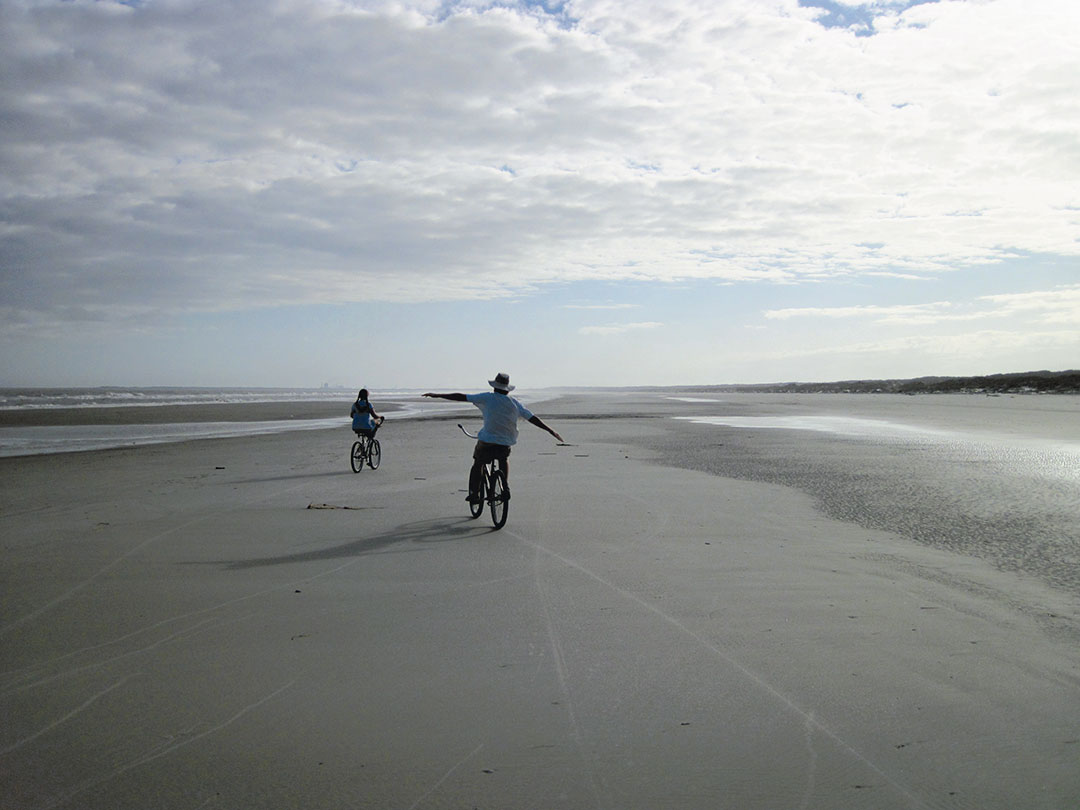
With a following breeze pushing them along, the author’s kids ride down part of the island’s 18-mile-long beach along the Atlantic Ocean.
Aside from the tour of Plum Orchard, you could get a real sense of life in one of these estates by booking a stay at Greyfield Inn—the only place to spend the night on the island unless you’re camping. In 1900, Lucy and Thomas Carnegie commissioned this mansion, located on 200 private acres, for their daughter. It was converted to an inn in 1962, and the Carnegie family still oversees it. While the inn has always lured the rich and famous, it drew worldwide attention in 1996 when John F. Kennedy Jr. and Caroline Bessette celebrated their wedding here, reportedly in an attempt to foil the paparazzi.
They chose to marry in a tiny chapel located near the northern end of the island in a community called The Settlement. Today, the First African Baptist Church stands as an equally notable yet utterly disparate historic structure to those enormous mansions. According to the NPS, The Settlement was where “African American residents were able to purchase their first deeded property on the island at the end of the 1800s.” Several of this church’s founders were freed slaves. Spare and simple, it possesses a quiet dignity and humble grace that tell an entirely different story about the island’s past.
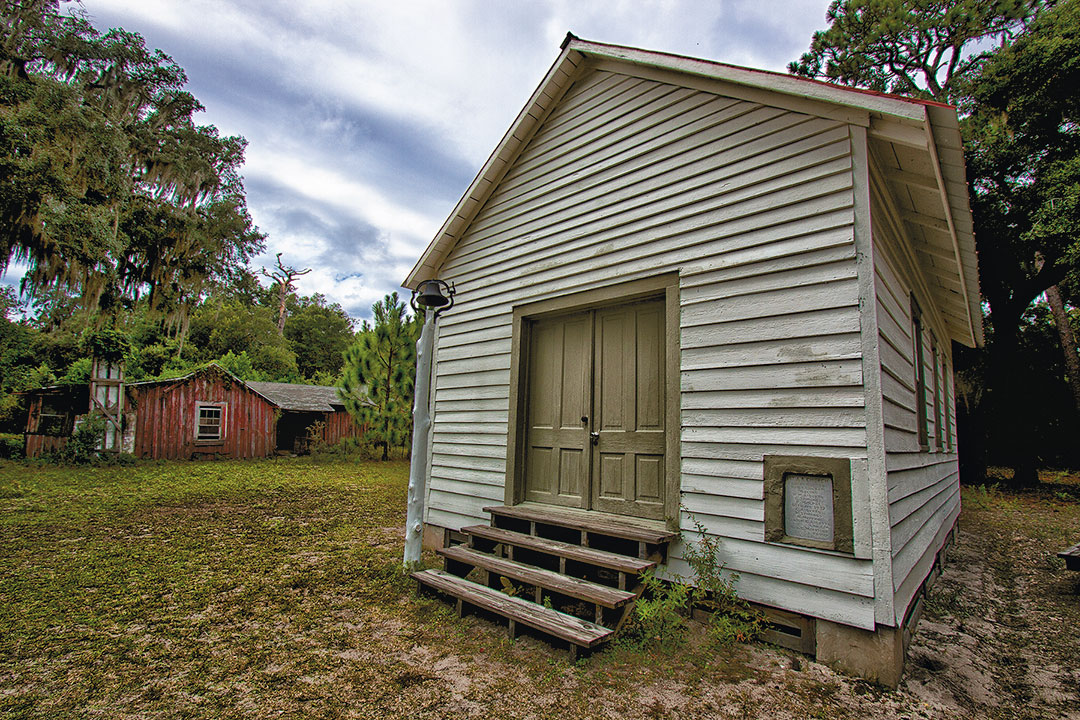
The original First African Baptist Church was built of logs in late 1893; the structure standing today was rebuilt in 1937. Photo courtesy National Park Service.
Yet, the human story of Cumberland Island isn’t as compelling as the natural history and the complex ecosystems packed into one small island. This was confirmed for me on the bike ride back to the ranger station. From the maritime forest, we took off on a side trail through the dunes. The scent of the sea grew stronger until it was before us, the vast Atlantic fronted by an expanse of beach. With a frisky breeze behind us, we sailed south, tires gliding over hard-packed sand.
“I cannot decide which is more beautiful, the maritime forest, the dunes, the marshes, or the beach,” I wrote, “so I walked an hour in the forest, listening to the wind rustle the palms below and watching it sweep the Spanish moss above. The live oaks there are the most amazing trees I’ve ever seen, curled and twisted like wooden flame…Then I walked through a cut over the dunes, which links the forest to the beaches, in and of itself a mysterious and seemingly barren place, yet here is what I saw: the tracks of hermit crabs, ghost crabs, armadillos, deer, wild ponies, the skittery paw print of sea oats bent over to brush the pure white sand, fine as talc.”
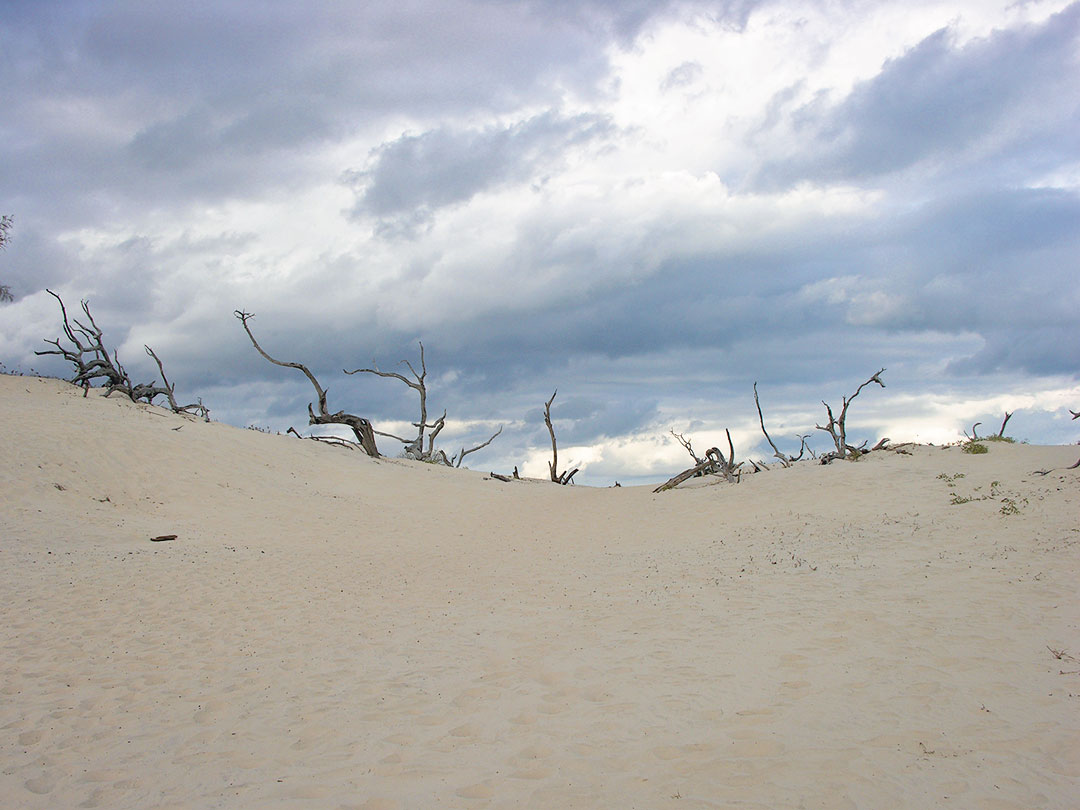
The dunes at Cumberland Island stretch as far as you can see and serve as a buffer between the sea and the maritime forest inland.
The 18-mile-long beach is one of Georgia’s most important nesting sites for federally threatened loggerhead sea turtles, and a park program monitors the nesting females each spring. According to the park’s website, in 2019 alone 885 sea turtle nests were noted, and between 2016 and 2019, monitors tallied more than 1,800 nests.
In the maritime forest, whole branches of live oaks are covered with bright green resurrection ferns, creating a tropical atmosphere. Prized by shipbuilders for their curves, angles, and strength, these trees were felled throughout the 1700s until, by 1802, only 20 percent of the island’s trees remained.
On the island’s western side, the saltmarsh dominates along Cumberland Sound. From the anchorage, we watched the sun set over the waterway and marsh, while skates jumped around the boat and the ever-present dolphins slid through the water.
A year after that first visit, we returned for another Thanksgiving, this time with several of our sailing friends and family who were also traveling south. We potlucked at picnic tables near the ranger station, and as the sun set over the sound to the west, I realized I didn’t feel lonely at all anymore. I felt like I was home.
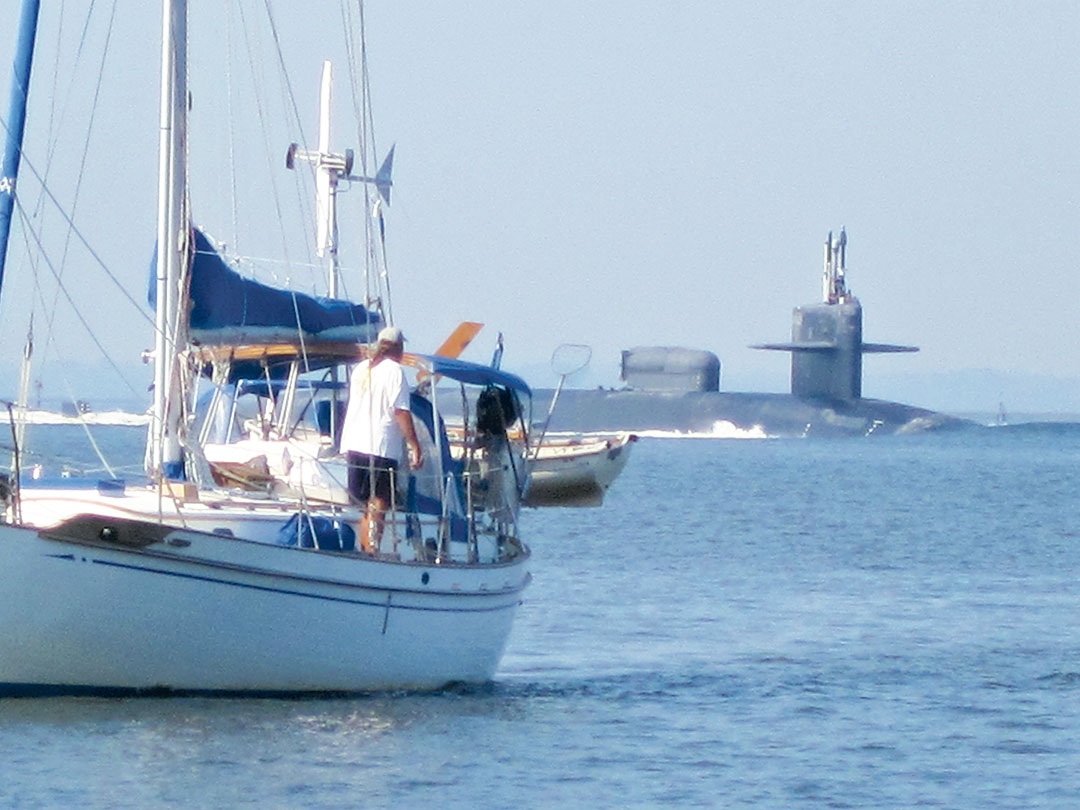
Cruising sailors heading for the anchorage at Cumberland Island look back at a submarine making its way to Naval Submarine Base Kings Bay.
Before you visit Cumberland Island National Seashore, check the website (nps.gov/cuis) for updates about COVID-19 restrictions, as well as any closures due to hurricane or storm damage. Although camping opened up in early July, the guided Lands and Legacies and Plum Island Mansion tours had not yet resumed.
Unless you’re arriving on your own boat, the main access to the island is via the Cumberland Island Ferry, which runs out of St. Marys. Find the ferry schedule and any updated restrictions at cumberlandislandferry.com. You can rent bikes and book tours (when they are running) through the ferry operator.
If you don’t have your own boat to retreat to each evening, camping offers an option to stay on the island overnight. You must make reservations online in advance at the park’s website. While Sea Camp is the largest and most easily accessible campsite on the island, others are more remote for more intrepid campers. Stafford Beach Campground requires a 31/2-mile walk-in and has some facilities, while Hickory Hill, Yankee Paradise, and Brickhill Bluff are designated wilderness sites with no amenities. They are between 5 and 10 miles from the Sea Camp dock and require that you carry in your food, hang it during the night, carry out your waste, and leave no trace.
If upscale is what you’re after, Greyfield Inn (greyfieldinn.com) is the grand option. The inn has its own ferry service from Fernandina Beach, Florida, which is directly south of Cumberland Island across the St. Marys River entrance.
No matter how you visit the island, a hearty bug spray is advisable.
If upscale is what you’re after, Greyfield Inn (greyfieldinn.com) is the grand option. Located on 200 private acres on the island, this is another restored Carnegie mansion, built by Lucy and Thomas Carnegie in 1900 for their daughter. It was converted to an inn in 1962, and the Carnegie family still oversees it. While the inn has always lured the rich and famous, it drew worldwide attention in 1996 when John F. Kennedy Jr. wed Caroline Bessette at the First African Baptist Church on Cumberland Island and held the reception at the Greyfield, reportedly in an attempt to foil any paparazzi. The inn has its own ferry service from Fernandina Beach, Florida, which is directly south of Cumberland Island across the St. Marys River entrance.
Wendy Mitman Clarke is Good Old Boat’s senior editor and a lifelong sailor. She’s also a science writer and editor at Maryland Sea Grant, and an award-winning poet and novelist.
Thank you to Sailrite Enterprises, Inc., for providing free access to back issues of Good Old Boat through intellectual property rights. Sailrite.com




